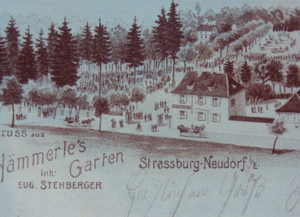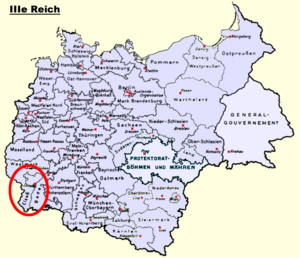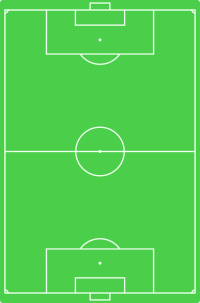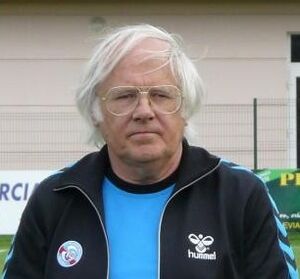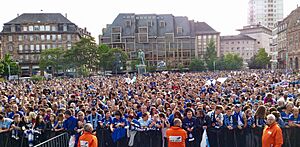RC Strasbourg Alsace facts for kids
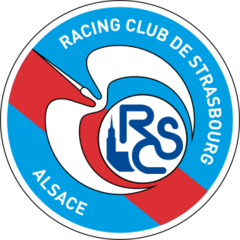 |
||
| Full name | Racing Club de Strasbourg Alsace | |
|---|---|---|
| Nickname(s) | Le Racing Le RCS Les Bleu et Blanc (The Blue-and-Whites) |
|
| Founded |
|
|
| Ground | Stade de la Meinau | |
| Capacity | 26,109 | |
| Owner | BlueCo | |
| President | Marc Keller | |
| Head coach | Liam Rosenior | |
| League | Ligue 1 | |
| 2021–22 | Ligue 1, 6th of 20 | |
|
|
||
Racing Club de Strasbourg Alsace, often called RC Strasbourg or just Racing, is a professional football club from Strasbourg, Alsace, France. It was started in 1906 and became a professional team in 1933.
Racing currently plays in Ligue 1, which is the top football league in France. The team won the 2016–17 Ligue 2 championship. This happened after the club faced financial difficulties and was moved down to the fifth level of French football in 2011. After being renamed RC Strasbourg Alsace, they worked their way back up, winning the CFA championship in 2012–13 and the Championnat National in 2015–16. Their home stadium, Stade de la Meinau, has been used by the club since 1914.
RC Strasbourg is one of only six clubs that have won all three major French football trophies. They won the French Championship in 1979. They also won the Coupe de France three times (1951, 1966, 2001) and the Coupe de la Ligue four times (1964, 1997, 2005, 2019). The club has played over 2,000 games in France's top league and has taken part in 52 European matches since 1961. However, they have also been moved down to lower leagues at least once every ten years since the 1950s.
The story of RC Strasbourg is closely connected to the history of Alsace. Just like the region, the club has changed nationality three times and has had a challenging past. When it was founded, Alsace was part of the German Empire. The club always focused on its Alsatian roots, unlike other Strasbourg clubs that were started by German people. When Alsace became part of France again in 1919, the club changed its name from 1. FC Neudorf to Racing Club de Strasbourg. This was a way to show their support for France, similar to the famous Racing Club de France. During World War II, RC Strasbourg players, like most Alsatians, faced difficult times. They were evacuated in 1939, then Alsace was taken over by Germany in 1940. Players tried to avoid being forced into the German army between 1942 and 1944. After Alsace was permanently returned to France, Strasbourg's identity became even more French. This was shown by their exciting wins in the French Cup in 1951 and 1966.
Contents
Club History
Racing Club de Strasbourg Alsace began in 1906 as Fußballclub Neudorf. Its history has often been unstable. First, there were political problems because the club played in both French and German championships. This was due to the ongoing disagreement between France and Germany over Alsace. Second, there were business issues. Despite these challenges, the team became successful in the French league. They won several trophies, with the most important being the championship in the 1978–79 season.
Early Years as Fußballclub Neudorf
In the early 1900s, football became popular in the German Empire, including Alsace–Lorraine. In Strasbourg, many football clubs started. Fußballclub Neudorf was founded by students from the Neudorf area. Their teacher helped them financially. The team's first game was against FC Germania, where they lost badly.
Over the next three years, the team, renamed Fußballclub Cäsar Neudorf, struggled. In 1909, with Louis Becker as president, Neudorf joined the Verband Süddeutscher Fußball-Vereine. This was a football association in southern Germany. Neudorf slowly got better. They played with a strong attacking style, winning games by large scores, including a 28–0 victory. This led to them moving up two divisions in two years. In 1914, just before reaching the first division, Neudorf got its first field, Hämmerlé's Garten. The Meinau Stadium was later built there. All sports stopped that same year because of World War I.
Joining French Football
After World War I, Alsace and Lorraine became part of France. The club changed its name to Racing Club de Strasbourg, honoring Racing Club de France. For the next ten years, Strasbourg played in the Alsace regional championship, winning it in 1923, 1924, and 1927. They also played in the Coupe de France starting in 1920–21. They never got past the round of 16, but in 1925–26, they surprised everyone by beating Red Star, a team that had won many national cups. During this time, the first wooden stands were built at their field, which became the Meinau Stadium.
In 1932, Strasbourg's leaders first said no to making the team professional. But a year later, after a vote, the team became professional and joined the second division.
After winning promotion games, Strasbourg competed with Sochaux for the top league title. Strasbourg started strong, but Sochaux eventually won the title. In the following years, the team, helped by German striker Oskar Rohr, became a solid mid-table team. In the 1936–37 Coupe de France, Strasbourg reached the final but lost 2–1 to Sochaux.
During World War II
At the start of World War II, when France was occupied by Germany, the team became an amateur club again. Some players who had fled to the south of France restarted it. After winning a regional championship, the team joined the German football system. They were renamed Rasensportclub Straßburg and played in the Gauliga Elsaß.
From then until Alsace was freed, Strasbourg played in the Gauliga four times. They finished second three times in a row. They also played in the 1941–42 German Cup, but were eliminated early. During this time, they had a strong rivalry with Red Star Strasbourg, which was renamed SS Strasbourg due to its connection with the German regime.
After the War
After the war, Alsace returned to French control, and Strasbourg rejoined the French football system. In the 1946–47 season, Strasbourg almost won two major trophies. They were close to winning the championship and reached the French Cup final, but lost to Lille.
In the years that followed, Strasbourg had mixed results. In the 1948–49 championship, the team was supposed to be moved down a league. However, they stayed up because Colmar gave up its professional status. Two seasons later, the team won its first official trophy, the 1950–51 French Cup. They beat Valenciennes in the final, leading to huge celebrations in Alsace. About 50,000 fans welcomed the team home.
Winning the cup did not make the team's results stable. They were moved down to the second division three times in the 1950s (1952, 1957, and 1960). However, they always returned to the top league quickly. In the 1954–55 season, led by Ernst Stojaspal, Strasbourg finished fourth in the league. They also reached the French Cup semifinals but lost to Lille.
Playing in Europe
In the early 1960s, Strasbourg played in a European competition for the first time. This was the 1961–62 Fairs Cup, where they were eliminated early. With financial help from the city, Strasbourg's results improved. In the 1964–65 season, the team almost won the league title. They were in second place, just one point behind Nantes, with four games left. They drew their direct match against Nantes and finished fifth. In the same season, they did very well in the Fairs Cup, reaching the quarterfinals. They beat strong teams like AC Milan and Barcelona. They were finally eliminated by Manchester United, who had won the first game 5–0.
The next season, Strasbourg reached the French Cup final for the fourth time. They beat Toulouse in extra time. In the final, they faced French champions Nantes and won 1–0. That same season, Strasbourg also played in the Fairs Cup again. They met AC Milan in the first round. After losing 1–0 away, they won the home game 2–1, forcing a deciding match. Milan won this match after a 1–1 draw.
In the following seasons, Strasbourg's results were not as good. In 1970, the club merged with an amateur team, Pierrots Vauban, and was renamed Racing Pierrots Strasbourg Meinau. However, this did not help. In the first season under the new name (1970-71), the team was moved down to Division 2, but returned to the top league the next year. Another move down in the 1975–76 season led to the club splitting. Pierrots Vauban was restarted, and the name Racing Club de Strasbourg was brought back.
Winning the Championship
After winning promotion back to the top league, Strasbourg started the 1977-78 season with mostly the same players. They added Jacques Novi, Francis Piasecki, and Raymond Domenech. Gilbert Gress, a former Strasbourg player, became the coach. He was known for his team's strong teamwork, using a 4-3-3 formation with attackers like Gemmrich, Tanter, and Vergnes. After a slow start, Strasbourg improved and aimed for a spot in European competitions. They finished third, which qualified them for Europe.
Building on this success, Strasbourg made few changes for the next season. They bought Roger Jouve and replaced Vergnes with the younger Wagner. The team started the championship even better, taking the lead early and keeping it throughout the season. On June 1, 1979, goals from Wagner and Ehrlacher in the final match against Lyon led to celebrations across Alsace. The next day, 200,000 fans welcomed the team at Strasbourg station.
A Period of Decline
After winning the national title, André Bord, a local politician, became the club's leader. He quickly disagreed with coach Gress. Bord brought in famous players like François Bracci and Carlos Bianchi, but they didn't fit Gress's team strategy. This conflict, known as the Affaire Gress-Bord, affected the team. They failed to defend their title but reached the quarterfinals of the European Cup, where they lost to Ajax.
The tension between Gress and Bord grew in the 1980–81 season. After a very bad start, fans supported Gress and demanded Bord's resignation. Bord stayed and fired Gress. This marked the end of Strasbourg's golden age. Most of the 1979 championship players left. New players like Didier Six and Jean-François Larios joined, but they couldn't bring back the team's success. Strasbourg stayed in the lower-mid table in the 1980s. In the 1985–86 season, they were moved down to Division 2. Bord resigned, leaving the team in financial trouble.
The new president, Daniel Hechter, wanted to rebuild the team. However, the club had huge debts. In 1990, a debt of 90 million French francs was discovered. Hechter had to resign.
Returning to Europe
The team, which had moved between the top and second divisions, was then led by Jacky Kientz. When they failed to win promotion in 1990–91, Gress was called back as coach. With young talents like Frank Leboeuf and Martin Djetou, Gress led the team back to Division 1. They won a key playoff game against Stade Rennais 4–0. Back in the top league, Strasbourg finished close to the UEFA qualification spots. After the next season, Roland Weller became president. Gress left the team, despite offers to stay, due to disagreements with some players.
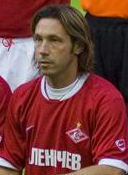
These changes did not immediately hurt the team. Former player Daniel Jeandupeux became coach. In the 1994–95 season, Strasbourg was in third place. After a dip in form, Jeandupeux was replaced by another former player, Jacky Duguépéroux. He led the team to the French Cup final (which they lost 1–0 to Paris Saint-Germain) and tenth place in the league. This qualified them for the new Intertoto Cup. By winning this competition, Strasbourg entered the UEFA Cup, returning to European play after sixteen years. Their journey ended in the round of 16 against AC Milan. In the next two seasons, despite losing key players, the team continued to qualify for European competitions. In the 1996–97 season, they finished ninth in the league. They also won the League Cup by beating Bordeaux in the final, which directly qualified them for the UEFA Cup.
On March 21, 1997, the IMG group, led by Patrick Proisy, took over the club. This brought hope, but the team had a poor season and barely avoided being moved down. That season is also remembered for their run in the UEFA Cup. After beating Rangers, Strasbourg faced Liverpool. They won 3–0 at home, which helped them qualify even after losing 2–0 at Anfield. Their European adventure ended in the third round against Inter Milan.
Duguépéroux left due to conflicts with the management, starting another difficult period for the team. They had bad seasons in the league and national cups. The worst moment seemed to be the 2000–01 season, when they finished last and were moved down to Division 2. However, they won their third French Cup that year, beating Amiens in the final. The game ended 0–0 and was decided by penalty kicks, with Strasbourg winning 5–4. This win qualified Strasbourg for the UEFA Cup, where they were eliminated early. This allowed them to focus on the league, where they finished second and returned to Ligue 1.
Changes, Crisis, and Comeback

The 2002–03 season saw the team avoid being moved down. The club's leadership also changed. The IMG group was replaced by a group of business people led by German businessman Egon Gindorf. With new coaches like Antoine Kombouaré and Jacky Duguépéroux, Strasbourg had two average seasons. In the 2004–05 season, they won their second League Cup against Caen (2–1). This qualified them for the UEFA Cup again.
Strasbourg seemed to be heading for another successful period. However, Philippe Ginestet becoming club president caused disagreements among the management. This affected the team's performance in the 2005–06 season, which ended with them being moved down early. This negative result was balanced by Strasbourg's good performance in the UEFA Cup, where they were eliminated by Roma in the round of 16.
After winning promotion back to Ligue 1 at the end of the 2006–07 season thanks to coach Jean-Pierre Papin, Strasbourg started the 2007–08 season with Jean-Marc Furlan as coach. The team struggled and finished second-last, being moved down again. Despite this, Furlan stayed as coach, but the team failed to get promoted back to Ligue 1 in the 2008–09 season.
At the end of that season, former player Léonard Specht took over the club. He brought back Gress as coach for the third time. However, the start of the 2009–10 season was confusing. Gress was replaced after just two losses. Specht also resigned, and Ginestet returned as president. He hired Pascal Janin. In November 2009, an English company, FC Football Capital Limited, took control of the club. Julien Fournier became president. These changes affected the team's results. Strasbourg was six points clear of the relegation zone with six games left, but they collapsed, earning only two points. They were overtaken by other teams and moved down to the third division.
At the end of the 2010–11 Third Division season, Strasbourg finished fourth and missed promotion to Ligue 2. The club then faced more financial issues and had to restart from the fifth division, the Championnat de France Amateur 2 Group C.
Climbing Back to Ligue 1
In 2011–12, the team quickly returned to the Championnat de France Amateur, the fourth division, by winning their group. In 2012, the team changed its name to Racing Club de Strasbourg Alsace and updated its logo. After winning the fourth division championship in 2012–13, the club returned to the Championnat National, the third division, within two years. For the 2014–15 season, Jacky Duguépéroux became coach. In 2015–16, Strasbourg won the National and returned to Ligue 2 after six years. In 2016–17, they continued their climb, winning the second division as a newly promoted team and reaching the top league. In the 2017–18 Ligue 1, the team finished 15th, avoiding relegation on the second-to-last day with a comeback win against Olympique Lyonnais. In 2018–19, the team won the French League Cup for the third time, beating Guingamp 4–1 on penalties in the final.
On June 22, 2023, BlueCo, a group that also owns the English club Chelsea, became the main owners of Strasbourg. In the 2024–25 season, Strasbourg finished seventh in the league, which earned them a spot in the UEFA Conference League.
Team Colors and Logo
While the city's colors are red and white, Racing has always played in blue and white. The exact reason for this choice is not known. Over the years, their most common uniform has been a medium blue jersey, white shorts, and medium blue socks. In recent years, the team has often used different shades of blue and white for their home jersey. Since 2007, the Flag of Alsace has been shown on the back of the club's shirt. Hummel is their current uniform designer. In the past, Adidas and ASICS also supplied their kits.
The club's current logo has been used, with some breaks, since 1976. It is generally seen as the most important one. It features a stylized stork (a symbol of Alsace), a red diagonal stripe from the city's coat of arms, and a picture of the Cathedral along with the club's initials: RCS. Between 1997 and 2006, the club used a different logo. This logo was meant to look more "modern" and show both the cathedral and a stork. However, many people thought it looked like the video game character "Pac-Man". In 2006, the new club management brought back the 1976 logo because supporters wanted it.
Home Stadium
Racing has played at the Stade de la Meinau in southern Strasbourg since 1914. The stadium hosted games during the 1938 World Cup and Euro 1984. Its maximum capacity was reduced from 45,000 to 29,000 in the 1990s to meet new safety rules.
Fans and Rivalries
Historically, Racing's roots are in the working-class neighborhoods of Neudorf, Meinau, and Polygone in southern Strasbourg. In the 1930s, the team was the only professional club in the area. With good results, it gained support throughout the city. In Strasbourg, like most French cities, there is only one professional football club, so there are no rivalries within the city. This is different from countries like Great Britain or Italy. Today, as the only professional football club in Alsace, Racing has a large fan base that covers both the Bas-Rhin and Haut-Rhin départements, as well as eastern Moselle. Fans outside this area usually have a personal connection to Alsace. The club also has ties across the Rhine river, especially a friendship with Karlsruher SC fans, and they play friendly matches regularly.
On average, attendance in Ligue 1 has been around 20,000 for a stadium that holds 29,000. Fan groups include the "Ultra Boys 90," the "Kop Ciel et Blanc," and the "Club central des supporters." Most of the fan groups and the loudest fans gather in the "Quart de Virage Nord-Ouest" (North-West quarter corner). Strasbourg supporters are known for being loyal but also critical. Former captain Corentin Martins once said that the Strasbourg public is "demanding, but fair." Racing is always an emotional topic in Alsace. People often say that you either love it or hate it, or even both, but it always makes you feel something.
Racing Strasbourg's main rival is Metz. Their matches are called the "Derby de l'Est" ("the Eastern derby") in France, even though the cities are 150 kilometers apart. There is a strong rivalry between the regions of Alsace and Lorraine, which leads to some tension between the fans. The two clubs played each other in the quarter-finals of the 1995 UEFA Intertoto Cup. This was the first time two French teams played each other in a European competition. Strasbourg won that game 2–0. When Mulhouse was a professional club, the two sides also had a rivalry that continues in youth teams.
Club Leadership
Overview
Racing's history has always been closely linked with local businesses and politics. In the 1930s, car manufacturer Emile Mathis, whose factory was near the stade de la Meinau, supported the club's move to professionalism. RCS quickly developed a rivalry with Sochaux, a team supported by Mathis' competitor, Peugeot. After World War II, Mathis stopped its business, and the club found other sponsors, including Crédit Mutuel, a large bank from Alsace. The city's local government also helped. In 1980, André Bord, a well-known local politician and former minister, became chairman. Bord used his connections in business and politics to try and make Racing a big name in French football. However, he soon clashed with the popular manager Gilbert Gress. This conflict reached a peak in September 1980 when Gress's departure caused anger and protests among fans during a game. This disagreement between the influential president and the talented manager, and the events of 1980, might explain why Racing couldn't stay at the top level after their 1979 title win.
In 1986, Bord left the professional section and introduced fashion designer Daniel Hechter as his replacement. Hechter had been banned from professional football before due to his involvement in a scandal at Paris Saint-Germain. However, his ban was reduced, allowing him to become president at Strasbourg. This was the first time an outsider led the club, but it failed in 1990 when the club was almost bankrupt. The city of Strasbourg saved Racing by buying a 49% share of the club. However, they had to give up this share a few years later because new laws limited public support for professional sports. In 1997, two groups wanted to buy the city's share and take control of the club. One was led by then-president Roland Weller, a local businessman. The other was from the American IMG-McCormack Group, through its French branch led by Patrick Proisy. IMG wanted to expand into European football and had tried to buy Marseille the year before. The American group presented an ambitious plan, including a new youth academy and stadium renovations. They eventually won the bid for Racing's ownership for 1.5 million euros. The club became a "Société Anonyme à Objet Sportif" and then a "Société Anonyme Sportive Professionnelle." This status is similar to a regular company, but with rules like not being able to be listed on the stock market and needing to keep ties with the original club association. Proisy became the chairman, controlling the professional team. However, he did not control the overall sports structure, which still owned the club's name and its connection to the French Football Federation (FFF). This led to a dispute in 2002 between Proisy and Bord (who was still chairman of the overall sports structure). For a time, the professional players could not wear "Racing club de Strasbourg" on their jerseys.
Proisy's time at Strasbourg was full of misunderstandings, frustration, and poor results on the field. Alsatian fans especially disliked that Proisy did not live in Strasbourg, instead managing the club from IMG's offices in Paris. Racing's problems and the city's refusal to fund a stadium expansion for the 1998 FIFA World Cup caused heated debates during the 2001 local elections. These issues contributed to the defeat of the mayor, Catherine Trautmann. In 2003, a group of local investors, including Egon Gindorf (who became chairman), Patrick Adler, Pierre Schmidt, and Philippe Ginestet, bought the club back. These investors had been club sponsors during the IMG era. The new owners bought the club for a symbolic one euro from IMG, who wanted to cut their losses after Mark McCormack's death. However, they had to cover a 3 million euro deficit to balance the 2002–03 budget. It is estimated that Racing lost 15 million euros during the IMG era, mainly due to questionable player recruitment.
Thanks to careful player transfers led by director Marc Keller and good attendance, the new management improved the club's finances. However, the club's financial situation remained fragile. In 2004, Gindorf faced personal and financial difficulties and wanted to reduce his involvement with Racing. It was expected that Philippe Ginestet would become the new chairman at the end of the 2004–05 season. However, Keller opposed this move. In June 2005, Keller clearly stated he would not work with Ginestet. Keller had been acting as the club's head since 2002 but was only a small shareholder. He used his popularity with supporters to block Ginestet's rise to chairmanship, causing a standstill throughout 2005 as the club searched for an investor. In the fall of 2005, it was announced that Alain Afflelou, a French optician owner and former president of Bordeaux, would be the new owner. But Ginestet outbid him and took control of the club in the middle of the 2005–06 season, forcing Keller to leave a few months later. Ginestet held a majority share for four years, which he sold at the end of 2009 for 1.6 million euros. The new owner was identified as Alain Fontenla, a French investment broker based in London. In 2010, Fontenla owned 85% of "Racing investissements," which in turn owned a majority share (70%) of EuroRacing, the main shareholder (78%) of the club. The other major shareholder was Lohr SA, an industrial group focused on transportation.
On June 22, 2023, BlueCo, the group that bought Premier League club Chelsea in May 2022, acquired a majority stake in the club.
Club Presidents
Below is a list of Strasbourg's 15 presidents since the club became professional in 1933. The president has not always been the actual owner of the club. For example, between 1990 and 1997, the city was the main shareholder, but they chose to let independent local business people be chairmen.
The 2009–10 season had a record five different presidents. Early in the season, Léonard Specht stepped down after firing Glibert Gress, whom he had appointed as manager. Philippe Ginestet then returned as president but left when the new owners took over in December. The new owners named Julien Fournier as the new Chief Executive. However, after some problems, Fournier quickly disagreed with the new main shareholder, Alain Fontenla. Fournier's contract was ended in February, and he was replaced by Luc Dayan temporarily. Just a month later, former Sochaux chairman Jean-Claude Plessis replaced Dayan.
|
|
Players
Current Team Squad
|
|
Players on Loan
|
Famous Former Players
RC Strasbourg does not have an official hall of fame. However, many players have been important to the club's history. 21 players have played for the French national team while at Strasbourg. The most notable is Oscar Heisserer, who played a record 18 times for France while with Strasbourg. He was the first Alsatian and the only RCS player to be captain for France. Dominique Dropsy, Léonard Specht, and Gérard Hausser also played more than 10 times for France while at the club. Marc Molitor is one of the few players to play for the national team while in the second division. The 1978–1979 championship season had the most Strasbourg players in the national team. On October 7, 1978, a record four RCS players (Dominique Dropsy, Roger Jouve, Francis Piasecki, Albert Gemmrich) played for France in a Euro 1980 qualifying game. This happened again a month later for a friendly against Spain (Dropsy, Piasecki, Gemmrich, and Léonard Specht). Frank Leboeuf and Marc Keller were the last RCS players to play for France during the 1995–1996 season. Leboeuf is one of two former RCS players who won the 1998 FIFA World Cup with France; the other is Youri Djorkaeff.

Players who once played for Strasbourg and later played for France include Olivier Dacourt and Richard Dutruel (both in 2004). Also, current French national team midfielder Morgan Schneiderlin came from RC Strasbourg's youth academy. He spent 14 years with the club before moving to Southampton after only five first-team games for Strasbourg. Schneiderlin then moved to Manchester United in 2015 and later to Everton in 2017.
Because regional feelings are still strong in Alsace, the performance of local players gets special attention. Seven of the ten players with the most appearances for Racing are from Alsace: René Hauss (who holds the record), Léonard Specht, René Deutschmann, Edmond Haan, Gérard Hausser, Jean Schuth, and Raymond Kaelbel. Since 1979, there's a tradition that every Racing team that won a trophy or reached a final had a player from Brittany as captain, manager, or both. Jacky Duguépéroux was captain of the 1979 team and won the Coupe de la Ligue in 1997 and 2005 as a manager. The 2001 Coupe de France winning team included Yvon Pouliquen as manager and Corentin Martins as captain. Pouliquen was also the captain for the 1995 final.
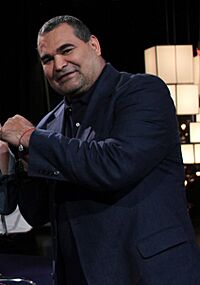
Besides French national players and Alsatians, Strasbourg has a strong history of having foreign players from Central and Eastern Europe. The successful Racing team of the 1930s often had Austrians as both players and coaches. This continued when Ernst Stojaspal played in the 1950s. Other players from Central Europe who are well-remembered include Elek Schwartz, Ivica Osim, Ivan Hašek, Alexander Vencel, and Danijel Ljuboja. Russian Aleksandr Mostovoi is the last world-class star to play for Racing so far. Also, one of the greatest goalkeepers of all time, the Paraguayan José Luis Chilavert, known for being chosen as the IFFHS World's Best Goalkeeper three times and for his free-kick skills, won the 2001 Coupe de France with the club.
Coaches
Strasbourg has had 47 different managers in its professional history, with the position changing 57 times. This is a record in French football, only surpassed by Marseille. Gilbert Gress holds the record for the longest time as manager at the club, both for a single period (39 months between 1977–80, 152 matches) and overall (75 months in three periods, 275 matches). Paul Frantz has been manager the most times at Racing, with four different periods (73 months overall, 227 matches). Jacky Duguépéroux is the only manager to win two trophies with the club.
Current Coaching Staff
| Position | Name |
|---|---|
| Head Coach | Liam Rosenior |
| Assistant head coach | Justin Walker |
| First-team coach | Kalifa Cissé |
| Goalkeeping coach | Sébastien Gimenez |
| Fitness coach | Dany Eberhardt |
| Youth coach | Martin Djetou Guillaume Lacour |
| Video analyst | Hachim Ali M'Bae |
Club Achievements
League Titles
- Ligue 1
- Winners: 1978–79
- Ligue 2
- Winners: 1976–77, 1987–88, 2016–17
- Championnat National
- Winners: 2015–16
- Championnat National 2
- Winners: 2012–13
- Alsace Champions
- Winners: 1923, 1924, 1926
- Dordogne Champions
- Winners: 1940
Cup Wins
- Coupe de France
- Winners: 1950–51, 1965–66, 2000–01
- Coupe de la Ligue
- Winners: 1963–64, 1996–97, 2004–05, 2018–19
European Titles
- UEFA Intertoto Cup
- Winners: 1995
Club Records
- Biggest victory: 10–0 (vs. Valenciennes, 1937–38)
- Biggest defeat: 0–8 (vs. Limoges, 1959–60)
- Biggest victory in European game: 5–0 (v. Grazer AK, 2005–06)
- Biggest defeat in European game: 2–10 (v. MTK Budapest, 1961–62)
- Record appearances: René Hauss (580 games; 421 in Ligue 1; between 1949 and 1969)
- Most consecutive appearances for the club: Dominique Dropsy (336 games; between 1973 and 1982)
- Most goals for the club: Oskar Rohr (118 goals; between 1934 and 1939)
- Most goals in a single championship season at the club: Oskar Rohr (30 goals; 1936–37)
- Oldest player: René Hauss (39 years, 351 days; vs. Nantes; December 11, 1966)
- Youngest player: Jacques Glassmann (16 years, 95 days vs. Nantes, November 25, 1978)
- Record attendance: 39,033, November 20, 1992, vs. Marseille
- Highest transfer fee paid: €22 million (to Club Brugge for Abakar Sylla in 2023)
- Highest transfer fee received: €18 million (from Al-Shabab for Habib Diallo in 2023)
Images for kids
See also
 In Spanish: Racing Club de Estrasburgo Alsacia para niños
In Spanish: Racing Club de Estrasburgo Alsacia para niños



